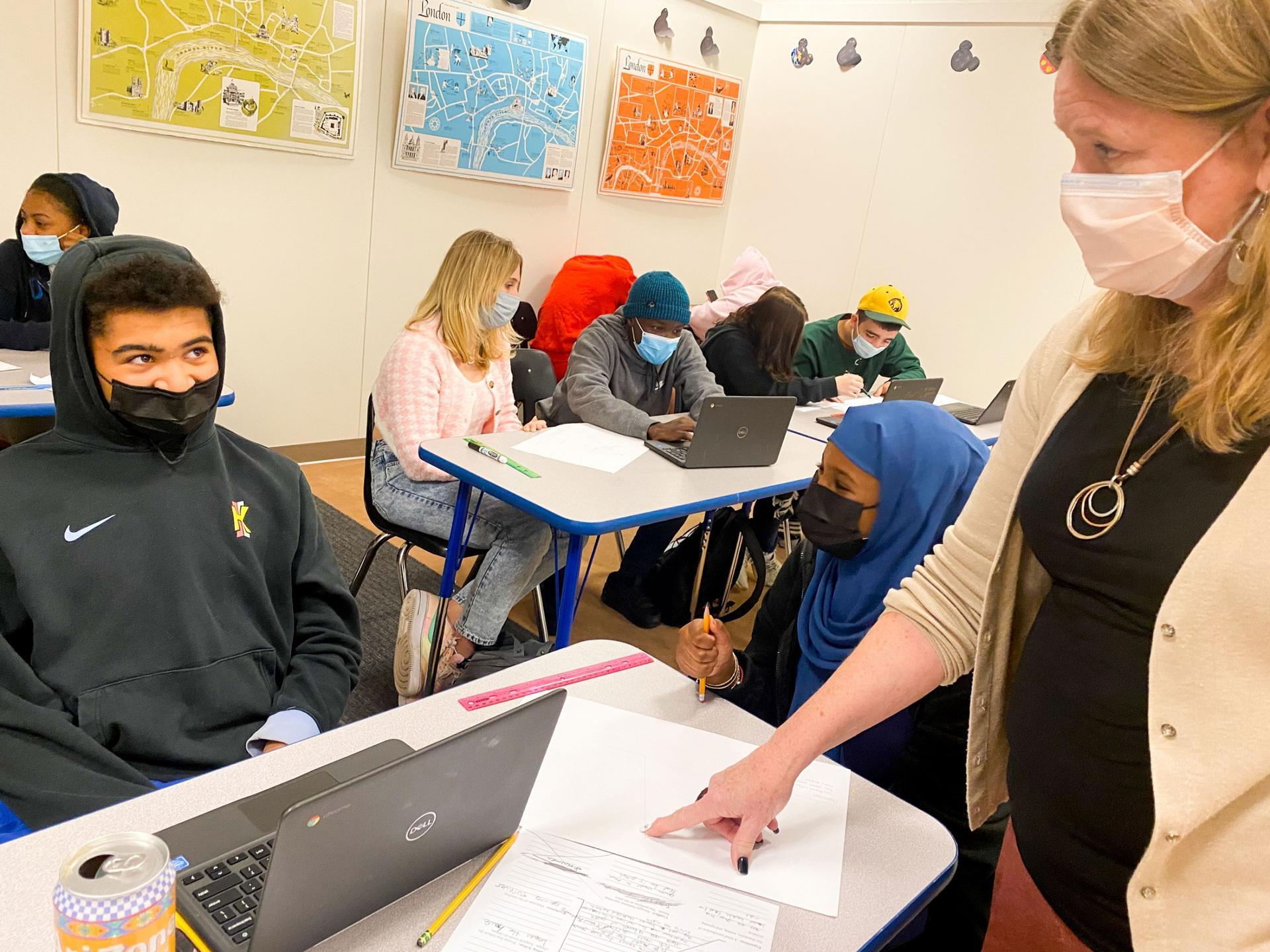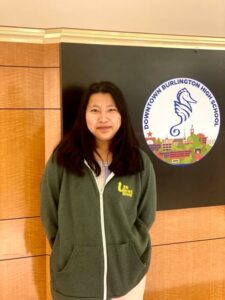Multilingual liaisons are ‘cultural brokers’ for refugee students in this Vermont school district

Teacher Susan Blethen supports students Kingston Kirkland and Isra Aden in this classroom in Burlington, Vermont. (Ben James)
In an office at Burlington High School, just off Lake Champlain in northern Vermont, Chacha Ngunga made a phone call.
“Jambo jambo,” he said, greeting a student’s father in their shared language, Swahili.
Ngunga is a multilingual liaison — one of 12 employed by the Burlington district.
A few feet away, Noor Bulle, another liaison, made a call in Maay Maay, one of the two major dialects of the Somali language. He reaches a Somali Bantu mother whose five children would soon enter district schools. The mother expressed amazement that her family was already on Bulle’s radar.
According to Bulle, the multilingual liaisons act as cultural brokers, helping refugee families understand how the U.S. school system works.
Bibek Gurung, a graduate of Burlington High, is now a junior at Champlain College in Burlington, studying criminal justice. He arrived in Burlington during fifth grade, speaking almost no English. He said his Nepali-speaking liaison helped him with high school and with what he calls life stuff.
“I was actually looking for a job, and he advocated for me,” Gurung said. “Through him, I was able to work for the Burlington Police Department as a beach and park patrol officer. He played a huge part in that.”
Shawna Shapiro, an associate professor at Middlebury College whose research focuses on the high school-to-college transition for refugee students, says many English learners in the U.S. finish high school unprepared for college. Part of the problem, she said, lies with English language learning programs that place students in lower-level academic classes, leaving them bored and underchallenged.
Shapiro said educators underestimate not only refugee students’ abilities, but also their cultural and family resources.
“When you talk with students … you hear [them say,] ‘I feel underchallenged,’ and then you pursue that a little more, and they say, “That’s frustrating because my parents were leaders in the refugee camp, and my mom was a professor, and my uncle was a police officer, and we’re here, and it feels like no one recognizes any of that,”” she said.
Samjana Rai, a college-bound senior who arrived from Nepal when she was in seventh grade, has heard a similar frustration from her peers about low expectations.

Samjana Rai is a college-bound senior in Vermont who arrived from Nepal when she was in 7th grade. (Ben James)
“A lot of my friends want to go to college,” Rai said. “But because of classes that they had to take in sophomore year, freshman year, it’s a little harder for them to go to the college that they want to go to.”
Rai has prepared as much as she can for college, taking advanced placement and college-level classes. She doesn’t see many refugee students in her upper-level classes, though, and she’d like that to change.
Mixed classes
Down the hallway from the multilingual liaison office, 30-year veteran teacher Susan Blethen introduced a lesson to her integrated class of native English speakers and English learners. It’s taught by two teachers: the regular subject teacher and Blethen, who is a specialist in English Language Learning.
“I don’t think a lot of the kids know I’m a language specialist,” Blethen said. “They just know me as Ms. Blethen.”
She directed her students in the making of plot diagrams for their favorite movies. Isra Aden, a multilingual, Somali-speaking ninth-grade student, was working on “Boyz n the Hood.”
“Rising action is like the main event which leads to a climax,” Aden said.
“And what’s the climax?” Blethen asked.
One purpose of the mixed classes, Blethen explained, is to make sure the English learners are being taught material that stimulates and inspires them to take on more challenges. In previous years, many of the English learners in this class would have been placed in what’s called “sheltered instruction,” separated from their native-English-speaking peers.
Blethen was the first teacher in Vermont to become certified as an English language learning instructor. She recalled a moment from early in her career.
“I actually had a social studies teacher yell at me when I was a young teacher, saying, ‘Why are they in my class if they can’t speak English? You have to teach them English before they can come into my class.’”
Times have changed, at least in Burlington, but some students here still question whether the multilingual liaisons and the mixed classes are making a significant difference in their education.
Standing with a group of her peers, Aden said the languages and cultures of refugee students are still undervalued at school, and the classes offered to English learners are often too easy.
“Bilingual people aren’t dumb,” Aden said, “and they can be challenged, and they can be doing higher things.”
Aden herself plans to take honors civics next semester.
“I thought, instead of doing an easy class, I should just challenge myself, because I’d be learning more if I did.”
Watching from nearby, Blethen nodded her head in approval.
This story from the New England News Collaborative was produced in collaboration with The World from PRX. Click here to listen to the audio story on the TheWorld.org.
